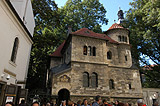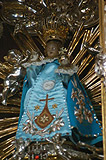Dolores O’Riordan in Prague
Oct 30, 14:20 Filed under prague-events
 Dolores O’Riordan is back. The singer of the legendary band Cranberries is starting her European tour while her band is being at rest and is going to perform in Prague with her accompanying band on Monday 26 November 2007 in Prague Lucerna.
Dolores O’Riordan is back. The singer of the legendary band Cranberries is starting her European tour while her band is being at rest and is going to perform in Prague with her accompanying band on Monday 26 November 2007 in Prague Lucerna.
The Cranberries is one of the most world famous band and all their hits will be performed on the Dolores O’Riordan tour in Prague. O’Riordan’s first solo album “Are You Listening?” was released on May 4, 2007 in the Republic of Ireland. The hit “Ordinary Day” was recorded in Prague and you can hear it at all music TV channels.
Dolores Eileen O’Riordan was born September 6th, 1971 as the youngest of seven children in Ballybricken, Limerick, Ireland. Her family was strict Catholic and she has a lot of respect for the good in the Catholic Church, but she doesn’t go to church. In 1990 she joined “The Cranberry saw Us” and later its name was changed to Cranberries at her request. On July 18th, 1994 O’Riordan married Don Burton, the former tour manager of Duran Duran. Now she lives in Howth, County Dublin with her husband and their four children (one is from a previous relationship of Burton’s).
If you come to her concert in Lucerna you will hear the Cranberries’ best hits including Linger, Animal Instinct, Zombie, Salvation, When You Are Gone and also hits from her new album “Are you Listening? “.
Tickets are available at the Ticketpro chain outlets and they cost 800 CZK (26,6 €). You can also buy the tickets right before the concert for the price of 950 CZK (31,6 €).
 Current number two of American rap is comming to the Czech Republic within the scope of his European tour (he didn’t cancel his tour, just moved it for two months). Tickets for his performance which is going to
Current number two of American rap is comming to the Czech Republic within the scope of his European tour (he didn’t cancel his tour, just moved it for two months). Tickets for his performance which is going to  Unfortunately for Prague, it is well known all around the world that local taxi drivers are not really honest. Especially if they see you are a tourist. Way too often they calculate that you don’t know the average pricing and they try to rip you off.
Unfortunately for Prague, it is well known all around the world that local taxi drivers are not really honest. Especially if they see you are a tourist. Way too often they calculate that you don’t know the average pricing and they try to rip you off. 
 You have now the extraordinary opportunity to see the holy statues of Baby Jesus of Prague, called the Bambino di Praga, together with his “mother” – the statue of Our Lady of Aparecida. Both famous statues are installed side by side in the church of Our Lady Vitorious – Infant Jesus of Prague.
You have now the extraordinary opportunity to see the holy statues of Baby Jesus of Prague, called the Bambino di Praga, together with his “mother” – the statue of Our Lady of Aparecida. Both famous statues are installed side by side in the church of Our Lady Vitorious – Infant Jesus of Prague.  The word octopus is mentioned in the title, but this article is not about a cephalopod, the creature who inhabits many diverse regions of the ocean, but it is about new concept of the National Library in Prague which resembles an octopus. You must have heard about the famous architect Jan Kaplicky and his concept of the new building for the National Library. He won the international architectural competition, which was declared by the International Union of Architects (UIA). Jury compound of world famous architects, the Mayor of Prague Pavel Bem and the Director of Library Vlastimil Jezek. The Czech architect Eva Jiricna lives in Great Britain and was a jury foreman.
The word octopus is mentioned in the title, but this article is not about a cephalopod, the creature who inhabits many diverse regions of the ocean, but it is about new concept of the National Library in Prague which resembles an octopus. You must have heard about the famous architect Jan Kaplicky and his concept of the new building for the National Library. He won the international architectural competition, which was declared by the International Union of Architects (UIA). Jury compound of world famous architects, the Mayor of Prague Pavel Bem and the Director of Library Vlastimil Jezek. The Czech architect Eva Jiricna lives in Great Britain and was a jury foreman.